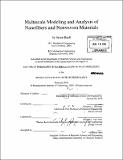| dc.contributor.advisor | Gregory C. Rutledge and Krystyn J. Van Vliet. | en_US |
| dc.contributor.author | Buell, Sezen | en_US |
| dc.contributor.other | Massachusetts Institute of Technology. Dept. of Materials Science and Engineering. | en_US |
| dc.date.accessioned | 2010-10-12T18:37:17Z | |
| dc.date.available | 2010-10-12T18:37:17Z | |
| dc.date.copyright | 2010 | en_US |
| dc.date.issued | 2010 | en_US |
| dc.identifier.uri | http://hdl.handle.net/1721.1/59213 | |
| dc.description | Thesis (Ph. D.)--Massachusetts Institute of Technology, Dept. of Materials Science and Engineering, 2010. | en_US |
| dc.description | Includes bibliographical references. | en_US |
| dc.description.abstract | Nanostructured fibrous materials have been made more readily available in large part owing to recent advances in electrospinning, which is a technique for the production of nanofibers with diameters down to the range of a few nanometers. The nonwoven structure has unique features, including interconnected pores and a very large surface to volume ratio, which enable such nonwoven materials to have many applications. The properties of the fibers and nonwoven fabrics produced, as well as the means for characterizing these, have remained bottlenecks in the development of the technology, both for scale-up purposes and for quality control and reproducibility during fabrication. The aim of this thesis is to model and identify the size dependent properties of polymeric nanofibers, to evaluate the interactions between two fibers and to construct a framework to model the nonwoven mats. First, molecular dynamics (MD) simulations are used to investigate the properties of polymeric nanofibers. The fibers consist of chains that mimic the prototypical polymer polyethylene that have diameters in the range 1.9-23.0 nm. We analyzed these nanofibers for signatures of emergent behavior in their structural, thermal and mechanical properties as a function of diameter. The mass density at the center of all fibers is constant and comparable to that of the bulk polymer. The surface layer thickness ranges from 0.78 to 1.39 nm for all fibers and increases slightly with fiber size. The calculated interfacial excess energy is 0.022 J/m² for all of the nanofibers simulated. The chains at the surface are more confined compared to the chains at the center of the nanofiber; the latter acquire unperturbed dimensions in sufficiently large nanofibers. Consistent with experiments and simulations of amorphous polymer films of nanoscale thickness, the glass transition temperature of these amorphous nanofibers decreases with decreasing fiber diameter, and is independent of molecular weight over the range considered. We find that, for a given temperature, the Young's elastic modulus E decreases with fiber radius and can be as much as 52% lower than that of the corresponding bulk material. Poisson's ratio v of the polymer comprising these nanofibers was found to decrease from a value of 0.3 to 0.1 with decreasing fiber radius. Our findings also indicate that a small but finite stress exists on the simulated nanofibers prior to elongation, attributable to surface tension. When strained uniaxially up to a tensile strain of [sigma]=0.2 over the range of strain rates and temperatures considered, the nanofibers exhibit a yield stress [sigma] between 40 and 72 MPa, which is not strongly dependent on fiber radius; this yield stress is approximately half that of the same polyethylene simulated in the amorphous bulk. Another focus of this thesis was to study the interfiber interactions between these nanofibers. For this purpose, we employ similar MD simulations and energy minimization, or molecular statics (MS). MD simulations show that fibers aligned parallel and within 9 nm of one another experience a significant force of attraction. These fibers tend to coalesce on a very short time scale, even below Tg. In contrast, our MS simulations suggest an interfiber interaction that transitions from an attractive to a repulsive force at a separation distance of 6 nm. The results of either simulation approach can be used to obtain a quantitative, closed-form relation describing fiber-fiber interactions. However, the predicted form of interaction is quite different for the two approaches. This difference can be understood in terms of differences in molecular mobility within and between fibers, and whether such mobility is appreciable or not. The results of these simulations are used to interpret experimental observations for electrospun polymer nanofiber mats. These findings highlight the role of temperature and kinetically accessible timescales in predicting interface-dominated interactions at polymer fiber surfaces, and prompt further experiments and simulations to confirm these effects in the properties of nonwoven mats comprising such fibers. Finally, we use a novel Monte Carlo (MC) technique which can incorporate since nanofiber properties and interfiber interaction. In this model, the nonwoven network is composed of several fibers that are represented by linked, cylindrical segments. Fiber flexibility is obtained by varying the material and geometrical properties of the segments in stretching, bending and twisting. We are able to create networks with different fiber orientations and with volume fractions of 5-25%, comparable to those of real electrospun nonwovens. | en_US |
| dc.description.statementofresponsibility | by Sezen Buell. | en_US |
| dc.format.extent | 140 p. | en_US |
| dc.language.iso | eng | en_US |
| dc.publisher | Massachusetts Institute of Technology | en_US |
| dc.rights | M.I.T. theses are protected by
copyright. They may be viewed from this source for any purpose, but
reproduction or distribution in any format is prohibited without written
permission. See provided URL for inquiries about permission. | en_US |
| dc.rights.uri | http://dspace.mit.edu/handle/1721.1/7582 | en_US |
| dc.subject | Materials Science and Engineering. | en_US |
| dc.title | Multiscale modeling and analysis of nanofibers and nonwoven materials | en_US |
| dc.type | Thesis | en_US |
| dc.description.degree | Ph.D. | en_US |
| dc.contributor.department | Massachusetts Institute of Technology. Department of Materials Science and Engineering | |
| dc.identifier.oclc | 666377890 | en_US |
